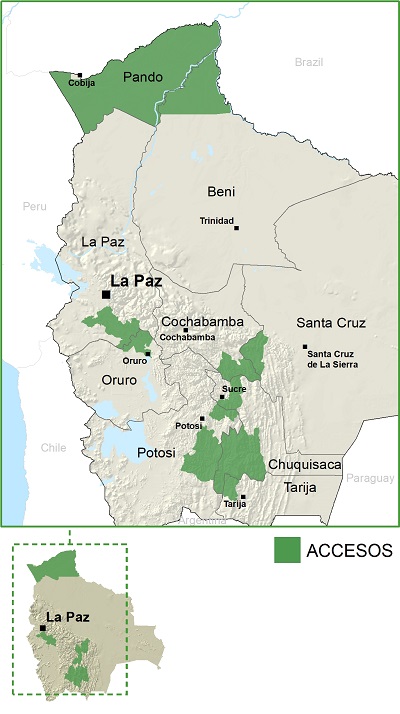Economic Inclusion Programme for Families and Rural Communities in the Territory of the Plurinational State of Bolivia (ACCESOS)
IFAD Asset Request Portlet
ناشر الأصول
Economic Inclusion Programme for Families and Rural Communities in the Territory of Plurinational State of Bolivia
This programme will strengthen the capacities of communal and territorial landholders and autonomous local governments, in alliance with other organizations and local institutions.
Specifically, it will support the community-based implementation of farming systems adapted to the widely varying conditions of high plateaux, inter-Andean valleys and some lowland areas.
In addition, ACCESOS will cofinance the development of self-organized community enterprises to connect producers with markets and create economic alternatives in the rural non-agricultural sector. It will particularly focus on women and young people. The programme will also promote broad-based access to financial services, including savings, credit and insurance.
ACCESOS targets rural municipalities that are among the poorest in the country and cover vast and diverse geographical areas, including La Paz, Oruro and Potosí; Cochabamba, Chuquisaca and Tarija; and Santa Cruz, Beni and Pando. The target area has a combined rural population of Quechua, Aymara and campesino households characterized by high levels of poverty or extreme poverty. The territories include a wide variety of ecosystems with fragile, threatened or degraded natural resources.
Key programme goals include:
- Greater sustainability, productivity and food security for small-scale rural producers
- Higher incomes from diversification of the rural economy
- Greater gender equity through increased access to training, investment capital, credit and other financial services
- Inclusion of poor and extremely poor families in viable economic alternatives
- Greater institutional and organizational capacities to manage natural resources
- Increased capacity to monitor, evaluate and apply lessons learned in development
- Improved resilience to the effects of climate change, particularly for collective landholders.
The target group comprises around 32,000 mainly food-insecure, poor rural households, or roughly 24 per cent of the total population in the programme area.

تقرير تصميم المشروعات
تقرير تصميم المشروعات
وثائق دعم الإشراف والتنفيذ
وثائق دعم الإشراف والتنفيذ
Misión de supervisión - abril 2018
Informe de supervisión, agosto 2017
الاسيت ببليشر
الاسيت ببليشر
الاسيت ببليشر
الاسيت ببليشر
الاسيت ببليشر
الاسيت ببليشر
الاسيت ببليشر
الاسيت ببليشر
الاسيت ببليشر
الاسيت ببليشر
الاسيت ببليشر
الاسيت ببليشر
الاسيت ببليشر
Related Contents
Related Contents
بوليفيا: برنامج الإدماج الاقتصادي للأسر والمجتمعات الريفية
جرّب برنامج التأقلم لصالح زراعة أصحاب الحيازات الصغيرة الخرائط الناطقة في بوليفيا. وقد جمعت هذه الأداة المبتكرة بين العلوم والمعرفة المجتمعية التقليدية لتحديد المسائل الرئيسية وأولويات التكيف، مانحة الشعوب الأصلية والنساء والشباب صوتا في صنع القرار.